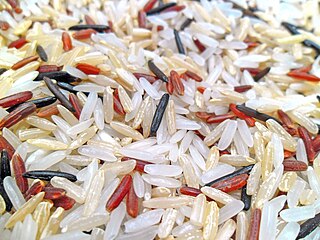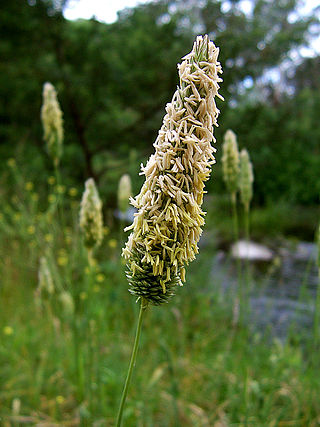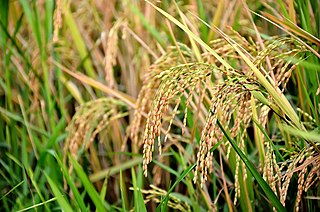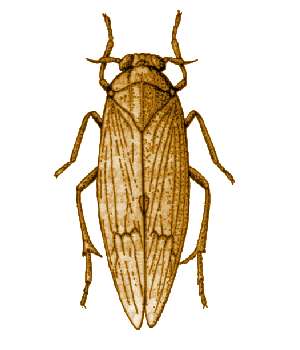
Rice is the seed of the grass species Oryza sativa or less commonly O. glaberrima. The name wild rice is usually used for species of the genera Zizania and Porteresia, both wild and domesticated, although the term may also be used for primitive or uncultivated varieties of Oryza.

Poaceae or Gramineae is a large and nearly ubiquitous family of monocotyledonous flowering plants commonly known as grasses. It includes the cereal grasses, bamboos and the grasses of natural grassland and species cultivated in lawns and pasture. The latter are commonly referred to collectively as grass.

Oryza is a genus of plants in the grass family. It includes the major food crop rice. Members of the genus grow as tall, wetland grasses, growing to 1–2 metres (3–7 ft) tall; the genus includes both annual and perennial species.

Oryza sativa, commonly known as Asian rice or indica rice, is the plant species most commonly referred to in English as rice. It is the type of farmed rice whose cultivars are most common globally, and was first domesticated in the Yangtze River basin in China 13,500 to 8,200 years ago.

Jasmine rice is a long-grain variety of fragrant rice. Its fragrance, reminiscent of pandan and popcorn, results from the rice plant's natural production of aroma compounds, of which 2-acetyl-1-pyrroline is the most salient. A rapid loss of aromatic intensity leads many Southeast Asians and connoisseurs to prefer each year's freshly harvested "new crop" of jasmine rice. Jasmine rice is a variety of Oryza sativa.

The brown planthopper (BPH), Nilaparvata lugens (Stål) is a planthopper species that feeds on rice plants. These insects are among the most important pests of rice, which is the major staple crop for about half the world's population. They damage rice directly through feeding and also by transmitting two viruses, rice ragged stunt virus and rice grassy stunt virus. Up to 60% yield loss is common in susceptible rice cultivars attacked by the insect. The BPH is distributed throughout Australia, Bangladesh, Bhutan, Burma (Myanmar), Cambodia, China, Fiji, India, Indonesia, Japan, North and South Korea, Laos, Malaysia, India, Nepal, Pakistan, Papua New Guinea, Philippines, Sri Lanka, Taiwan, Thailand, and Vietnam. Their alternative host plant other than rice is Leersia hexandra.
Rice ragged stunt virus (RRSV) is a plant pathogenic virus of the family Reoviridae.
Rice stripe tenuivirus is an RNA plant pathogen of the genus Tenuivirus. It is prevalent in Japan, China, and Korea and can infect plants of the family Poaceae, which include wheat and corn. Damage from this disease causes major reductions in rice crop yield every year.

Oryza longistaminata is a perennial species of grass from the same genus as cultivated rice. It is native to most of sub-Saharan Africa and Madagascar. It has been introduced into the United States, where it is often regarded as a noxious weed. Its common names are longstamen rice and red rice.

Leersia oryzoides is a species of grass known by the common name rice cutgrass or just cut-grass. It is a widespread grass native to Europe, Asia, and North America and present in many other regions, such as Australia, as an introduced species. This is a rhizomatous perennial grass growing to a maximum height between 1 and 1.5 meters. The leaves are up to about 28 centimeters long and have very rough, minutely toothed edges. The inflorescence is a loose, open array of wavy, hairlike branches bearing rows of spikelets. Each spikelet is a flat fruit with a rough, bristly lemma without an awn, and no glumes. Some of the spikelet branches develop within the sheaths of the leaves and are cleistogamous. This grass is sometimes used for erosion control and restoring wetlands.

Oryza glaberrima, commonly known as African rice, is one of the two domesticated rice species. It was first domesticated and grown in West Africa around 3,000 years ago. In agriculture, it has largely been replaced by higher-yielding Asian rice, and the number of varieties grown is declining. It still persists, making up an estimated 20% of rice grown in West Africa. It is now rarely sold in West African markets, having been replaced by Asian strains.
Porteresia coarctata is a species of grass in the family Poaceae, native to India, Sri Lanka, Bangladesh, and Myanmar.

Oryzeae is a tribe of flowering plants in the true grass family, Poaceae. It contains 11 genera, including both cultivated rice (Oryza) and wild rice (Zizania).

Herpetogramma licarsisalis, the grass webworm or pale sod-webworm, is a moth in the subfamily Spilomelinae of the family Crambidae.
Oryza punctata is an annual grass in the rice genus Oryza, also known as red rice, related to cultivated rice O. sativa. O. punctata forms clumps or tussocks from 50–120 cm tall. It is a native to tropical Africa and Madagascar but is also found in Thailand and other parts of Indochina. O. punctata is a weed species in commercial rice growing operations although it appears to be rare in its native range. O. punctata has an IUCN status of least concern. It is not generally eaten or used as fodder by farmers but there is some evidence that it has been used as such during periods of famine. Due to the importance of the crop varieties of rice globally, the evolution of the Oryza genus as a whole has been studied extensively. A lot of information about O. punctata has been elucidated as a secondary benefit to this commercial research. O. punctata evolved some 5 million years ago in the second of two rapid radiation events that occurred in the Oryza L. genus.
Tungrovirus is a genus of viruses, in the family Caulimoviridae, order Ortervirales. Monocots and family Poaceae serve as natural hosts. There is only one species in this genus: Rice tungro bacilliform virus. Diseases associated with this genus include: stunting, yellow to orange leaf discoloration with fewer tillers. Tungro means 'degenerated growth' in a Filipino dialect and the virus was first observed in the Philippines 1975.
Oryza is a genus in the plant family Poaceae, of which Oryza sativa is a member. Oryza is a genus of 24 species, most of which are annual and some perennial grasses, which are found in tropical and swampy parts of Africa, Asia and Australia. Given its wide geographic range, there exists a substantial diversity of specialized metabolites in the genus Oryza. Understanding this diversity can provide us solutions for mitigate crop losses due to disease and pest damage in rice, and boost agricultural production.
Oryza officinalis is species of flowering plant in the genus Oryza (rice) native to India, Nepal, the eastern Himalaya, southeast Asia, south-central and southeast China, Hainan, the Philippines, New Guinea, and the Northern Territory and Queensland in Australia. A perennial diploid with the CC rice genome, it can reach 3 m (10 ft) in height. It is the namesake of a widespread species complex.
Oryza latifolia, the broadleaf rice, is a widespread species of grass. It is native to wetter areas of Latin America and the Caribbean, and has been introduced to India, Bangladesh, Myanmar, Laos, and Vietnam. A facultative aquatic perennial, if flooded it can adapt by growing considerably taller.










